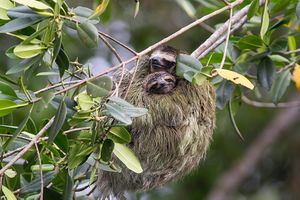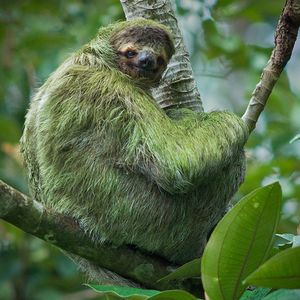Sloth evolution
Introduction

Despite their similar appearances, the rise of modern sloths is an interesting story of convergent evolution. There are two families of sloths, the two-toed sloth and the three-toed sloth, but there are six different species total. Two-toed sloths belong to the genus Choloepus and three-toed sloths belong to the genus Bradypus. Known for their slow movements and inefficient digestive systems, these creatures populate South American and Central American rainforests. Their diets mainly consist of leaves and fruits. All species of sloths spend their time in the rainforest canopy, spending between 15-20 hours a day sleeping, and only venturing to the floor in order to defecate.[1] The forest floor is full of predators that sloths mainly avoid by hiding in the forest canopy. Although both genus of sloths move little, the three-toed sloth moves an average of 5.4 hectares, while the two-toed sloth moves up to 140 hectares per day.Cite error: Closing </ref> missing for <ref> tag it was discovered that the Bradypus and Choloepus species evolved through convergent evolution, which is where organisms with different ancestors or from different periods evolved similar phenotypes or traits.
By examining the fossils from the ancestors of sloths, it was also proven that convergent evolution occurred instead of divergent evolution. Researchers examined the collagen in fossils instead of the DNA from fossils.[2] This was done because DNA is normally not able to be extracted from fossils. The collagen was used to recreate the proteins of the extinct animals. Through this process, it was revealed that the two-toed sloth is grouped with Megalonychidae, which encompasses ground sloths, including the giant land sloth.[2] The three-toed sloths were grouped with the Bradypodidae family. This means that two and three-toed sloths are not closely related. Instead, they evolved to have similar phenotypes through convergent evolution.
Microbiome

Sloths have a mutualistic relationship with moths that live in their fur.[3] The algae that grows in sloth fur not only camouflages the sloths in the tree canopy, but also provides a source of nutrients for the sloths. The algae is rich in lipids and aids in digestion. This is essential for the sloth, because they only defecate once a week. If they do not have regular bowel movements, this increases the mass of the sloth, and can increase the risk of falling from the tree. Although the spines of sloths are flexible, falling from a high height to the ground can kill a sloth. Their predators are also abundant on the forest floor, making any time spent on the ground dangerous. This means that the weekly trips to the ground to defecate are also dangerous for sloths. In order to survive, a short time spent defecating is necessary.
One of the main mysteries of sloths was their purpose in venturing to the forest floor to defecate. This has recently been explained by research about the mutualistic relationship that exists between sloths and moths. The amount of algae that grows in a sloth's fur is dependent on these moths. There are several species that colonize sloth fur, where they mate and live. By living in sloth fur, these moths avoid predators and have a steady food source, the algae. When the sloth climbs down the tree to defecate, a female moth will lay her eggs in the feces of the sloth. The larval moths then return to sloth fur, where they grow and the cycle repeats. Recent research suggests that sloth moths increase the amount of nitrogen that is present in the fur.[3] The more abundant nitrogen is, the more the algae grows. The three-toed sloths appear to have a higher concentration of moths and algae, which may be due to the more limited movement of the three-toed sloth. The sloths are dependent on this algae, which is a proposed explanation for why they aid in the life cycle of the moths by climbing down the trees to defecate.
Conclusion
Two-toed and three-toed sloths who were previously thought to be closely related, are perhaps more distantly related than previously believed. Research suggests that they evolved from different families of extinct animals, meaning they evolved through convergent evolution. However, both of these sloths are similar in the cultivation of algae in their fur to promote digestion. The moths that live in their fur are also essential in the growth of algae. Both two and three-toed sloths have filled a similar niche in forest environments, despite their proposed differing ancestry.
References
- ↑ Gardner, Alfred L. “Sloth.” Encyclopædia Britannica, Encyclopædia Britannica, Inc., 13 June 2019, https://www.britannica.com/animal/sloth.
- ↑ 2.0 2.1 Presslee, S., Slater, G.J., Pujos, F. et al. 2019. Palaeoproteomics resolves sloth relationships. Nat Ecol Evol 3, 1121–1130 doi:10.1038/s41559-019-0909-z
- ↑ 3.0 3.1 Pauli, J. N., Mendoza, J. E., Steffan, S. A., Carey, C. C., Weimer, P. J., & Peery, M. Z. (2014). A syndrome of mutualism reinforces the lifestyle of a sloth. Proceedings of the Royal Society B: Biological Sciences, 281(1778), 20133006. doi: 10.1098/rspb.2013.3006
Edited by Cassandra Lis, student of Joan Slonczewski for BIOL 116 Information in Living Systems, 2019, Kenyon College.

